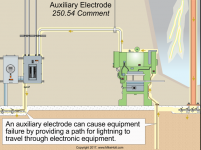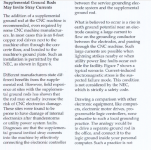lshaff01
Member
- Location
- Melbourne Florida
- Occupation
- Retired Electrical Engineer
I was reviewing Mike Holt’s video “Grounding - Safety Fundamentals” on the internet and noticed something I was curious about. About 31 minutes in, (Statement 1) Mike shows how an equipment ground (earth ground) is required by the NEC at the service entrance and at a breaker box at a remote building some distance away. He says this is required for lighting protection i.e. to give a path the earth for lighting current to pass.
Later in the video, about 51 minutes in, (Statement 2) Mike shows how extra remote earth grounds connected to equipment is a bad idea. He says if there is a lighting strike near the extra remote ground, it can result in a voltage difference between the extra remote ground and the service entrance ground. This voltage difference can result in a current pulse that can travel from the extra remote ground through the equipment via the equipment ground wire to the service entrance ground rod. This can result in damage to the equipment.
These two statement seem juxtaposed in that: (1) is placing a earth ground at both the service entrance and a remote breaker box a good idea because the NEC says so or (2) is it a bad idea because a lighting strike near the remote ground rod will result in a current pulse that can travel from the remote ground rod through the equipment ground wire to the service entrance ground rod that will damage the remote breaker box and/or the service entrance breaker box?
Please comment. I hope I got my point across. Putting this in words without being able to draw pictures and wave my hands was difficult.
Later in the video, about 51 minutes in, (Statement 2) Mike shows how extra remote earth grounds connected to equipment is a bad idea. He says if there is a lighting strike near the extra remote ground, it can result in a voltage difference between the extra remote ground and the service entrance ground. This voltage difference can result in a current pulse that can travel from the extra remote ground through the equipment via the equipment ground wire to the service entrance ground rod. This can result in damage to the equipment.
These two statement seem juxtaposed in that: (1) is placing a earth ground at both the service entrance and a remote breaker box a good idea because the NEC says so or (2) is it a bad idea because a lighting strike near the remote ground rod will result in a current pulse that can travel from the remote ground rod through the equipment ground wire to the service entrance ground rod that will damage the remote breaker box and/or the service entrance breaker box?
Please comment. I hope I got my point across. Putting this in words without being able to draw pictures and wave my hands was difficult.





